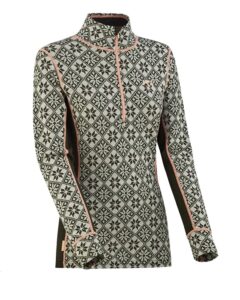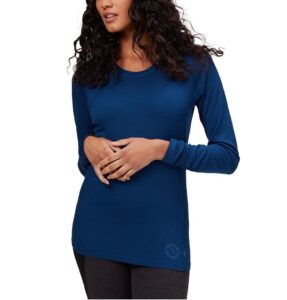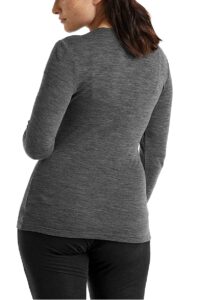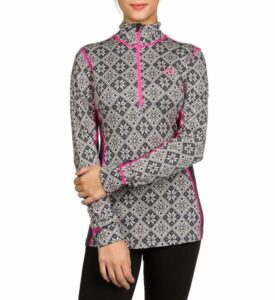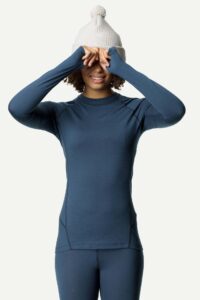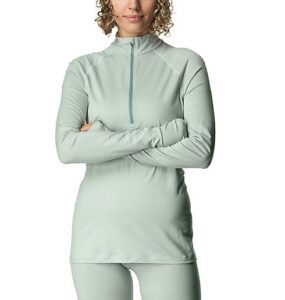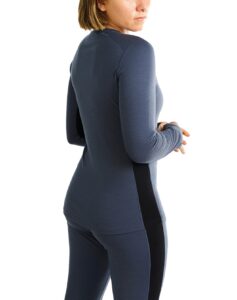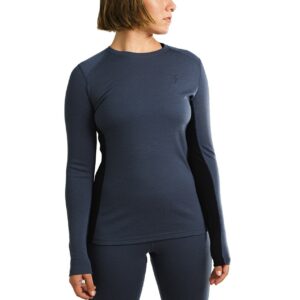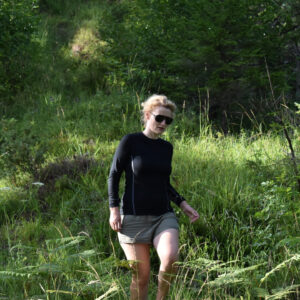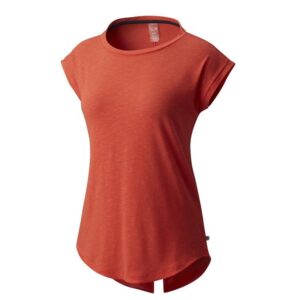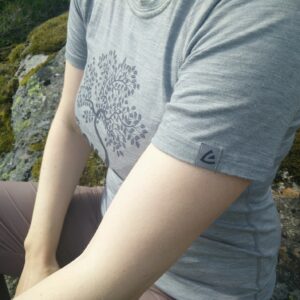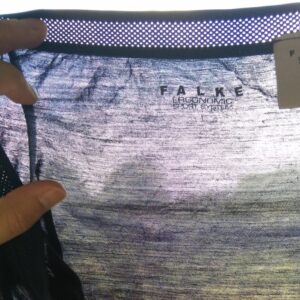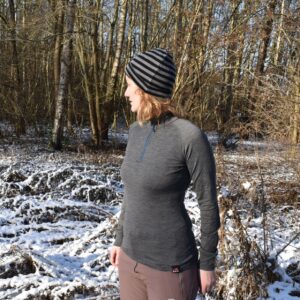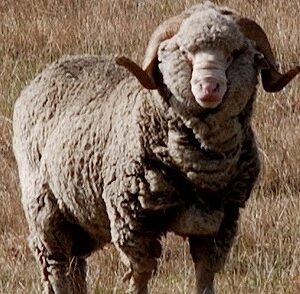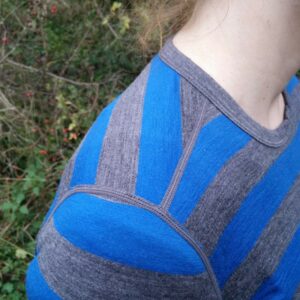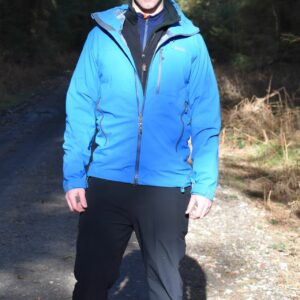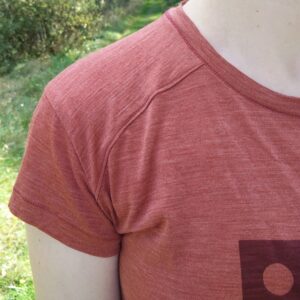A base layer top is worn directly over your sports bra and should thus feel comfortable against the skin and be breathable, moisture-wicking and quick-drying. A base layer should feel comfortable against the skin and be breathable, moisture-wicking and quick-drying. Base layers can both be made of natural and synthetic fabrics as well as blends of these, but Merino wool stands out among all these materials (to learn more, read Comparison of base layer materials). Besides fulfilling the criteria above, Merino wool has unique antimicrobial properties due to its natural content of fatty acids (namely lanolin) which means that it inhibits the growth of bacteria which would otherwise make your sweat (and thus clothes) smell bad. This makes Merino wool garments the perfect choice for longer hiking trips where you might go days without possibility for washing your clothes. Furthermore, Merino wool also keeps you warm even when wet (read why in our in-depth article Why you should wear Merino wool clothing); If you are planning to use your Merino top as a stand-alone piece in warmer weather, you might be happy to know that the material naturally absorbs radiation throughout the entire UV-spectrum and thus provides protection against the sun’s damaging UV-rays.
For those who have never felt the sensation of a high-quality Merino wool fabric, it must be noted that it is nothing like wearing an old-school Ragg wool garment. Merino wool is known for being non-itchy and comfortable to wear, having a surface a bit like brushed cotton. Who knows – you might get so addicted to the comfortable feeling of Merino wool that you will wear your base layer day in and day out – whether in the city or on the trails.
Below we have chosen five different brands which make superb Merino wool base layer tops and our respective favorites within each line to help you getting orientated about the options currently available.
Updated Content
We regularly update our reviews and selections to always recommend you the best products on the market.
Expert Selections
We only list top-tier products. Read how our selections of best hiking products differ from others here.
Links
We use affiliate links and may receive a small commission on purchases at no extra cost to you.
1. Our Picks of Merino Base Layers for Women
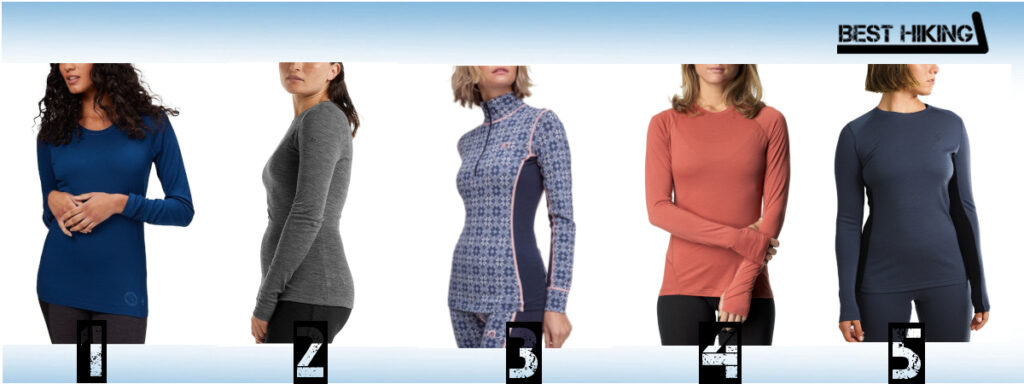
Best Merino Base Layers for Women
- Smartwool Classic All-Season Merino Base Layer
- Icebreaker Oasis Merino Base Layer
- Kari Traa Rose Merino Base Layer
- Houdini Desoli Merino Base Layer
- Ibex Woolies 2 Merino Base Layer
2. Comparison of Women’s Merino Base Layers for Hiking
| Feature/Product | Smartwool Classic All-Season | Icebreaker Oasis | Kari Traa Rose | Houdini Desoli | Ibex Woolies 2 |
|---|---|---|---|---|---|
| Fabric Composition | 87 % Merino wool, 13 % nylon | 100 % Merino wool | 100 % Merino wool | 100 % Merino wool | 100 % Merino wool |
| Fabric Density | 150 g/m2 | 200 g/m2 | 240 g/m2 (main) | 150 g/m2 | 240 g/m2 |
| Fineness of wool fibers used | Ultrafine (usually ≤17.5 microns) | 17-19 microns | n/a | 17.5 microns | 18.5 microns |
3. The Selection
1. Smartwool Classic All-Season Base Layer
Suitable for:
- Hiking
- Mountaineering
- Trekking
- Backpacking
Smartwool offers several base layers in Merino blends of varying densities and compositions – from 73% to 100% Merino wool. For this list we choose the lightweight Smartwool Classic All-Season base layer, made of 87 % Merino wool spun around a nylon core (13 %) for added durability. As the name implies, the lighter density of 150 g/m2 makes it suitable for all seasons. This Merino base layer is available with a crew neckline or a half-zip neck with a higher collar for more warmth – or ventilation. The Smartwool Classic All-Season base layer for women is sewn together with smooth flatlock seams, and in the sides it has been constructed so that the seams wrap to the front for a more flattering fit. Smartwool does not disclose the exact fineness of the Merino fibers used, but simply describe it as “ultrafine”, which usually means 17.5 microns or finer.
Pros:
- Lightweight Merino fabric makes it suitable for use in warm weather as well.
- Flat-lock seams
- Side seams wrap to front for body-enhancing fit
- Increased durability due to nylon core
Cons:
- /
Where to buy?
Also available at:
2. Icebreaker Oasis Merino Base Layer
Suitable for:
- Hiking
- Mountaineering
- Trekking
- Backpacking
Icebreaker is the pioneering brand when it comes to Merino wool for hiking clothing and thus it is no surprise that it offers several high-quality base layers in both 100% Merino wool as well as blends with synthetic materials for increased durability. The Icebreaker Oasis line for women is made of 100 % Merino wool, and is available as a long-sleeved base layer with either a crew neck line, scoop neck or half-zip neck. Regardless of your preferred neckline, the Icebreaker Merino base layer is made with flatlock seams to eliminate chafing, gusseted underarms for freedom of movement, a drop-tail hem for added coverage, and offset shoulder seams, so you can carry a heavy backpack without a seam rubbing against the top of your shoulders. Icebreaker does not disclose the exact fineness of the Merino fibers used, but merely states it is between 17 and 19 microns.
Pros:
- Lightweight Merino fabric makes it suitable for use in warm weather as well.
- Side seams wrap to front for body-enhancing fit
Cons:
- /
Where to buy?
Also available at:
3. Kari Traa Rose Merino Base Layer Top
Suitable for:
- Hiking
- Mountaineering
- Trekking
- Backpacking
The Norwegian brand Kari Traa has been a favorite in Europe and Scandinavia for almost a decade, but only in 2015 did it enter the US market and is thus still relatively unknown. Kari Traa offers multiple high-performance base layers in Merino wool with an emphasis on bright colors and flattering fit without sacrificing functionality. The Kari Traa Rose top is a great example of this as it mixes 4-way stretch Merino wool of two different densities in a streamlined design where the main part of the top is made of mid-weight Merino (240g/m2) to keep you warm, while the sides and underarm area are made out of a much lighter Merino wool (180g/m2) to provide ventilation where you need it the most. The Kari Traa Rose top is available in three different models which all allow enhanced ventilation; a button up version and two half-zip models – with or without a hood.
Pros:
- Uses Merino wool of varying densities to ensure both warmth and ventilation.
- 4-way stretch.
- Made of Extra Fine Merino wool (19.5 micron in fiber diameter)
Cons:
- Price
Where to buy?
Also available at:
Video

4. Houdini Desoli Merino Base Layer
Suitable for:
- Hiking
- Mountaineering
- Trekking
- Backpacking
Swedish Houdini is known for its sustainable practices, and also offers a base layer and underwear line in biodegradable and responsibly sourced 100 % Merino wool, which consists of two long-sleeved base layers, a short-sleeved t-shirt, bikini briefs, and tights (full-length and ¾) with a fabric density of 150g/m2. The long-sleeved Houdini Desoli base layer is available both as a crew neck and a half-zip neck, and made of superfine 17.5 micron Australian Merino wool. As described in our review of the Desoli crew neck base layer, it features a raglan sleeve construction, underarm gussets and augmented tailoring down along the sides for improved freedom of movement. The base layer is made with flat lock seams, cut quite long and also has thumb holes at the cuffs on the long sleeves. You can read the full review of the Houdini Desoli crew neck base layer here. Note that the sleeves are a bit narrow, and that you might have to size up depending on the buffness of your biceps.
Pros:
- Flatlock seams all-around
- Raglan sleeves, underarm gussets and augmented tailoring
- Sustainably produced
Cons:
- Quite narrow sleeves
5. Ibex Woolies 2 Merino Base Layer
Suitable for:
- Hiking
- Mountaineering
- Trekking
- Backpacking
The American brand Ibex specializes in Merino wool and is becoming increasingly popular among outdoor enthusiasts. The company offers two different lines of Merino base layers for women, where Ibex Woolies 2 are mid-weight base layers made of 100% Merino wool with a density of 240g/m2 while the lighter 180 g/m2 Woolies Tech base layers are made of a Merino blend (81% Wool, 12% Nylon, 7% Elastane). Both lines are available with a crew neck and with a half-zip neck, and made from 18.5-18-9 micron fine wool from free range sheep in Australia or New Zealand. All Ibex Merino base layers are made with raglan sleeves and extended underarm gussets for optimal freedom of movement, flatlock seams and baste stitch thumb holes, which you can use whenever your hands need a bit of warmth. Color-wise, Ibex changes its range from year to year, but it’s usually black along with two-three other fashionable colors.
Pros:
- Made of Superfine Merino wool from free range sheep
- Extended underarm gussets and raglan sleeve construction
- Small brand focused on sustainability
Cons:
- Price
4. Buying a Women’s Merino Base Layer – What is important?
Fabric density:
Merino wool can be knitted together more or less densely, resulting in fabrics weighing from 135 g to 400 g per square meter. The lighter the fabric density, the more breathable, lightweight and quick-drying the base layer will be. However, it will also be less able to reduce your body’s conductive heat loss and thus less warm. Base layers made of Merino wool with a density of 150 g/m2 or less can be used efficiently in warm weather and thus deflate the myth that wool is only for use in winter. However, heavier densities are mainly for use in fall, winter and spring where the base layer has to keep you warm above all. Base layers with fabric densities above 250 g/m2 are generally considered inefficient for sports use as they are quite heavy and take too long to dry when soaked with sweat. When buying a merino base layer, you should therefore consider which seasons and activities you intend to use it for and select a product with an appropriate fabric density accordingly.
Seams:
A base layer goes directly on your skin and its seams therefore need to feel comfortable – or not “felt” at all. You can achieve this by choosing garments sewn together with flatlock stitching, which is also stretchy and durable. This is especially important if the base layer is tight-fitting, while a looser top can be made with conventional seams without it bothering you. You can read more about flatlock seams here. If you are planning to carry a (heavy) backpack, your Merino base layer should preferably have offset shoulder seams, as a conventional shoulder seam at the top of your shoulders will surely chafe you, because the weight of the backpack will press down in this area.
Fit:
A tight-fitting base layer reduces heat loss and thus provides a little extra warmth, which is great for cold conditions, while a more loose-fitting garment will allow ventilation, which is a plus in warmer weather. Depending on your intensions, consider to size up or down – again keeping the fabric density of the respective base layer in mind. Tight-fitting base layers are easier to layer on top of, but thin loose-fitting Merino tops shouldn’t cause too much hassle either.
Sun Protection (UPF-rating):
Merino wool naturally protects against UV-rays and Merino base layers can therefore be categorized as sun-protective clothing. The level of UV-protection is rated as UPF (Ultraviolet Protection Factor) which indicates how many percentages of UV-rays penetrate through the fabric; a UPF of 30 and 50 means that 1/30 (≈3.3 %) and 1/50 (≈ 2 %) of UV-radiation enters through the fabric respectively. The UPF is not only dependent on the fiber type (Merino, polyester, cotton etc.) itself, but also on factors such as construction, amount of stretch, dyes, treatments and condition of the garment (brand-new or worn-out), so it is hard to assess it on your own and manufacturers do not always disclose it. For Merino base layers, you can usually count on a UPF of at least 25, but some offer protection up to UPF50. To learn more about the various UPF-rating factors, read the article Sun Protective Clothing for Hiking.
Care:
All the Merino wool base layers listed above can be washed at wool programs (low temperatures, less centrifugation) in the machine and some of them can even be tumble-dried gently. You should, however, avoid tumble-drying your wool garments as much as possible as the process will take a toll on the garment and decrease its lifespan. However, Merino wool doesn’t absorb that much water as cotton for example, so air-drying it shouldn’t take too long. You should also avoid fabric softener and bleach as these can affect the properties of Merino wool, and just use a special wool detergent instead. You can read more in our article on How to Wash Outdoor Clothing. If you spot tears or small holes in your Merino wool base layer, you should repair them as soon as possible. Read how in our guide to repairing Merino wool.
